Arctic Cat F570
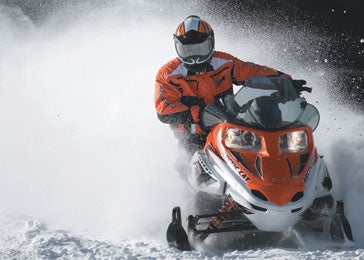
F-series soul with a fan-cooled heart.
When you look at Arctic Cat for 2008, you see some old familiar names didn’t make the switch to the new Twin Spar chassis. Panther and Bearcat stay in the line, but those names are on the older chassis. At first glance it seems there are few of the old name econo-Cats that made the transition to the Twin Spar platform. But, if you look closely, you’ll find a few fan-cooled value models still available.
In recent years —okay, the last decade— the three, two-stroke sled manufacturers upgraded their fan-cooled engines to run cleaner and more efficiently. Most of these engines evolved from 440cc and 500cc twins to 550s or bigger. In Cat’s case one of its remaining fan-cooled motors evolved into a 570cc, while a smaller 340cc version grew to 370cc.
Engine Type:Horizontal In-line
Cylinders:2
Engine Stroke:2-Stroke
Valve Configuration:Reed Valve
Displacement:565 / 34.5
Starter:Electric / Pull
Turbocharged:No
View Full SpecWith fan-cooled engines, sled makers can offer low-buck entries to entice price-conscious buyers. That usually means you’ll find the old school two-strokes laboring under the hood of a base touring model, a wide-track utility sled or a stripped down performance wannabe. But, like Ski-Doo with its MXZ 550x, Cat bucks that trend by placing its 570 fan engine in its F-series sport sled line-up. Don’t mistake the F570 for a high-performance screamer. Rest assured, it will give you plenty of on-trail action as it derives the same benefits from the F-series Twin Spar platform as its faster, more powerful liquid-cooled brethren.
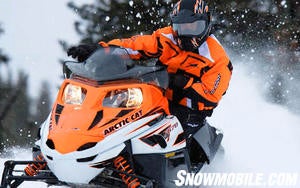 The lightweight trail Cat comes ready for fun.
The lightweight trail Cat comes ready for fun.
570 Fan-cooled
With the twin cylinder motor tucked low in the Twin Spar engine compartment, making major adjustments a chore. Fortunately the dual Mikuni VM34 carburetors should require little tinkering, as they are a long-term proven commodity. The Suzuki-built twin sits upright to accommodate the crossflow engine design. That means the two-into-one exhaust gets tucked into the nose cone area, while the carbs must face aft toward the seat. This engine placement works well for the fan-cooled engine as cold air enters from two flared nostrils in the nose piece. This helps control under hood temperatures. Fresh air is ducted to the carbs through a baffle chamber designed to quiet the intake while supplying adequate airflow to the dual Mikunis.
The more powerful liquid-cooled F-series engines have the intake and exhaust on the same side of the engine, so they can sit down low for improved handling and center of gravity.
With about 60–horsepower at sea level —substantially less at 11,000 feet in the Rockies— the Suzuki delivers performance via Cat’s own roller cam driven secondary and rpm-sensing drive clutch. The ACT direct drive system is used on most models, including the F570. Now in its sixth season, this system replaces a traditional jackshaft and chaincase with a sequence of gears. You should notice a much smoother transition of power, especially with reduced engagement rpm. The simplified drive system helps maintain the Cat’s low center of gravity.
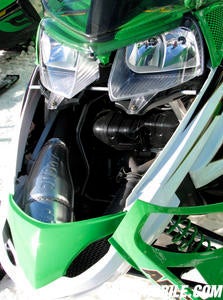 Suzuki-built, fan-cooled twin fits snugly in the Twin Spar chassis.
Suzuki-built, fan-cooled twin fits snugly in the Twin Spar chassis.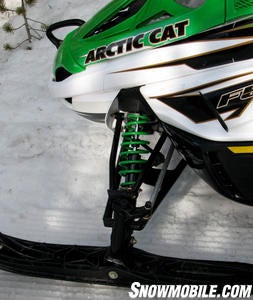 F570 comes with hydraulic shocks on the AWS VII front suspension.
F570 comes with hydraulic shocks on the AWS VII front suspension.Twin Spar Stiff
The Twin Spar chassis is said to be more than 46 percent stiffer than the previous Firecat chassis. As with Ski-Doo’s pyramid frame, the Cat design features triangulated braces to secure the front while reinforcing the tunnel area. We found much less twist in this chassis when running through rough, bumpy turns than with the Firecat or even the Crossfire.
Since the F570 engine is air-cooled, the sled is immediately lighter. All that plumbing needed with a liquid-cooled engine is gone. We’d expect a fueled-up F570 to weigh around 550-pounds with its 10.8 US gallon fuel tank, which makes the standard reverse gear beneficial when off-loading this (or any) sled.
Another benefit of the Twin Spar chassis being the backbone of the F570 is that you get all of the new suspension packages. Albeit the F570 comes with a base version of the AWS VII front end, it is Cat’s latest design. You’ll get the same forged spindle and shock tower as owners of the F-1000 high performance model. There’s a new roller-bearing mounted steering post for an increased steering angle, which translates into a tighter turning radius.
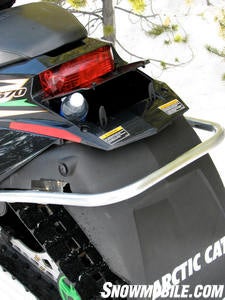 You can stow gloves, ball cap- and a beverage in the rear trunk.
You can stow gloves, ball cap- and a beverage in the rear trunk.
Upgrade Or Not
Of course, there are trade-offs when buying the lower echelon F570. That new AWS suspension may provide the same 9.5–inches of travel, but the F570 comes with less expensive hydraulic shocks instead of gas bag versions. If you ride really hard, the hydraulic shocks will fade much more quickly than gas shocks. Depending on your riding style, you might want to save for a shock package upgrade, which can make a noticeable difference. This also applies to the Slide-Action rear suspension and its 13.5–inches of travel. Base hydraulic shocks are used to control the front and rear action.
If you are sport rider and mainly ride groomed trails, save your money and enjoy a long snowmobile weekend at a nice resort. The F570 is a very good ride overall, but most serious sports riders would move to a liquid-cooled F-series anyway.
What we enjoyed about the F570 was its overall civilized feel. Many low buck, fan-cooled sleds manage to make you feel like you couldn’t afford something nicer. Not the case with the F570. It is a very stylish mount. Choose red, green or black. Most non-Cat snowmobilers won’t know that this is the base “F” model from looking at it. Credit Cat designers for that.
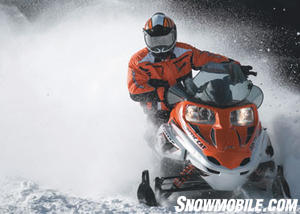 The F570 is priced right with many of the best F-series features.
The F570 is priced right with many of the best F-series features.
Smart Buy
There is a great deal to like with the F570. It starts with pricing (US$6,499/C$8,399). Then toss in the all-new rider-friendly Twin Spar platform, a reliable fan-cooled twin, new front and rear suspensions, and rich styling. You end up with a sled that will bring smiles to your face whether you are just getting into the sport or are a longtime veteran looking for on-trail fun aboard a sled that is decade-durable and a smart buy. That’s how we see the 2008 Arctic Cat F570. It’s a smart buy.








 Your Privacy Choices
Your Privacy Choices